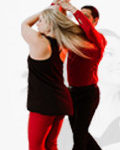In the post on rhythm units, we described double and triple rhythms. To wit: a double rhythm has two weight changes within 2 beats of music, and a triple rhythm has three weight changes in two beats of music.
One way to make your dancing fit the music is to dance triples when you hear a triple melody (e.g., an & count accented in the music) while dancing doubles through double melody (like when there is a constant bass drum on each beat). However, it’s hard to do this constantly because you are likely to end up on the wrong foot a lot (which is an especially big problem for followers if they aren’t on the correct foot for a spin). Also, in a competitive setting, dancing doubles and triples without regard to the basic pattern structure of WCS can make it look like you don’t know your rhythms.
An alternative way to make your dance fit the music is to listen for the double or triple melodies, but then make your double rhythms feel like triples if that’s what the music calls for (and vice versa). If you change the look of the first two beats of the pattern so that it has a triple feel while actually performing a double rhythm, you will still be on the correct foot and you will look like you know the pattern structure of WCS. This drill refers to double and triple “rhythms” in scare quotes because we’re going to make doubles look like triples, and vice versa.
The Drill—Doubles into Triples:
To make a double feel like a triple, you need to add an extra action that doesn’t involve a weight transfer. Ball change steps (kick ball change, point ball change, knee pop ball change, etc.) all work for this because you have two weight transfers (the ball, and the change), but three actions (the kick/point/knee pop, the ball, and the change).
On your own, practice doing basic patterns with some version of a ball change on the first two beats of the pattern. Once you are comfortable with the basic movement, turn on a song with a strong triple feel (like Etta James’ “I Sing the Blues” or Brother Yusef’s “I Got the Blues). For the entire song, dance basic patterns that feel like triples: use ball changes on every double rhythm and triples during every triple rhythm.
The Drill—Triples into Doubles:
Making triple steps look like doubles requires taking away an action. Unfortunately, it’s not possible to take away a weight transfer and end up on the same foot. So, making triples look like doubles actually requires turning the triple into a single (another odd unit), and then adding a non-weighted action to create a second action in that rhythm unit.
There are two options for making triples look like doubles, depending on whether you need to move your center throughout the 2 beats or just at the end. If you just need to move your weight by the end of the 2 beats, like on an anchor, you can use a delayed single. On the downbeat, you can move your leg without putting weight on it in a point, kick, or ronde. On the upbeat, transfer your weight.
Option two is useful in scenarios where your center needs to be moving throughout the pattern (as in the 3&4 of the follower’s side pass). In this version, you will use a normal single rhythm. Transfer your weight on the downbeat. If you really need to travel, you can stylize this movement with a slide. On the upbeat, gather your foot (if you traveled) or create a new action, such as a knee pop or press (if your feet are already under you).
To make the gathering motion look like a second action, and not just a continuation of the step, it is important to put energy into the gather and make it a defined movement. Your goal here is a crisp, deliberate motion rather than a relaxed, fluid settling.
The drill here is the same for making doubles look like triples. Pick a song with a strong and steady beat (great choices include Jimmy Sommers’ “What Am I Gonna Do” and almost any top 40 song from The Black Eyed Peas, Ke$ha, Lady Gaga, etc.). Dance your basics, turning every triple into either a single with a second action or a delayed single.
Note for Leaders: It’s very easy to become lazy and turn all of your triples into singles with points or knee pops. Fight that urge! A general rule is: if you replace one of the triples from your pattern, you should do the other triple. If you replace both triples, you must do basic footwork on your next pattern, period. If you become comfortable with the single rhythms, you will end up doing them more than you think. Keeping this rule in mind will help stop you from doing singles every time.
Note for Followers: Followers, you have to be careful when changing your triples in the middle of patterns. Anchors and walk-walks at the beginning of the pattern are fair game for you to stylize, but trying to change up your footwork in the middle of patterns can create problems when the leader asks for a spin that you weren’t expecting. As you practice on the social floor, pay close attention to whether your leader is hinting that there’s a spin coming, and be prepared to abort if you get a spin out of nowhere.




 Brian & Megan
Brian & Megan